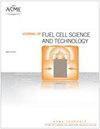Electrochemical Characterization of Synthesized Ni–Co and Ni–Co–Fe Electrodes for Methanol Fuel Cell
引用次数: 11
Abstract
Pt based materials having high electrocatalytic properties are normally used for the electrodes of the fuel cell. But the cost of the material limits the commercialization of alcoholic fuel cell. Non-Pt based metals and alloys as electrode materials for methyl alcohol fuel cells have been investigated with an aim of finding high electrocatalytic surface property for the faster electrode reactions. Electrodes were fabricated by electrodeposition on pure Al foil, from an electrolyte of Ni, Co, and Fe salts. The optimum condition of electrodeposition was found by a series of experiments, varying the chemistry of the electrolyte, pH, temperature, current, and cell potential. Polarization study of the coated Ni–Co or Ni–Co–Fe alloy on pure Al was found to exhibit high exchange current density, indicating an improved electrocatalytic surface with faster charge– discharge reactions at anode and cathode and low overvoltage. Electrochemical impedance studies on the coated and uncoated surface clearly showed that the polarization resistance and impedance were decreased by Ni–Co or N–Co–Fe coating. X-ray diffraction (XRD), energy dispersive X-ray spectroscopy (EDX), and atomic absorption spectroscopy (AAS) studies confirmed the presence of alloying elements and constituents of the alloy. The morphology of the deposits from scanning electron microscope (SEM) images indicated that the electrode surface was a three-dimensional space which increased the effective surface area for the electrode reactions to take place. [DOI: 10.1115/1.4029063]甲醇燃料电池合成Ni-Co和Ni-Co - fe电极的电化学表征
具有高电催化性能的铂基材料通常用于燃料电池的电极。但材料的成本限制了酒精燃料电池的商业化。研究了非铂基金属和合金作为甲醇燃料电池的电极材料,目的是为更快的电极反应寻找高电催化表面性能。用镍、钴和铁盐作为电解液,在纯铝箔上电沉积电极。通过改变电解液的化学性质、pH值、温度、电流和电池电位等条件,进行了一系列实验,找到了最佳的电沉积条件。对Ni-Co或Ni-Co - fe合金在纯铝表面进行极化研究,发现其交换电流密度较高,表明其电催化表面得到改善,阳极和阴极充放电反应更快,过电压低。电化学阻抗研究表明,Ni-Co或N-Co-Fe涂层明显降低了极化电阻和阻抗。x射线衍射(XRD)、能量色散x射线光谱(EDX)和原子吸收光谱(AAS)研究证实了合金元素和合金成分的存在。扫描电镜(SEM)形貌表明,电极表面为三维空间,增加了电极反应发生的有效表面积。(DOI: 10.1115/1.4029063)
本文章由计算机程序翻译,如有差异,请以英文原文为准。
求助全文
约1分钟内获得全文
求助全文
来源期刊
自引率
0.00%
发文量
0
审稿时长
6-12 weeks
期刊介绍:
The Journal of Fuel Cell Science and Technology publishes peer-reviewed archival scholarly articles, Research Papers, Technical Briefs, and feature articles on all aspects of the science, engineering, and manufacturing of fuel cells of all types. Specific areas of importance include, but are not limited to: development of constituent materials, joining, bonding, connecting, interface/interphase regions, and seals, cell design, processing and manufacturing, multi-scale modeling, combined and coupled behavior, aging, durability and damage tolerance, reliability, availability, stack design, processing and manufacturing, system design and manufacturing, power electronics, optimization and control, fuel cell applications, and fuels and infrastructure.

 求助内容:
求助内容: 应助结果提醒方式:
应助结果提醒方式:


